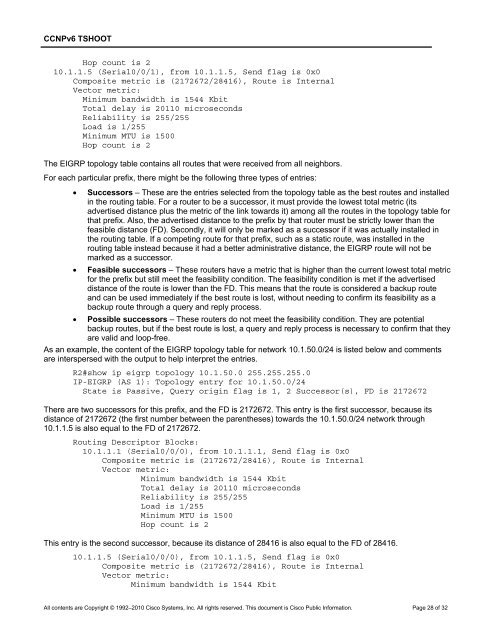CCNP TSHOOT 6.0 - Cisco Learning Home
CCNP TSHOOT 6.0 - Cisco Learning Home
CCNP TSHOOT 6.0 - Cisco Learning Home
You also want an ePaper? Increase the reach of your titles
YUMPU automatically turns print PDFs into web optimized ePapers that Google loves.
<strong>CCNP</strong>v6 <strong>TSHOOT</strong><br />
Hop count is 2<br />
10.1.1.5 (Serial0/0/1), from 10.1.1.5, Send flag is 0x0<br />
Composite metric is (2172672/28416), Route is Internal<br />
Vector metric:<br />
Minimum bandwidth is 1544 Kbit<br />
Total delay is 20110 microseconds<br />
Reliability is 255/255<br />
Load is 1/255<br />
Minimum MTU is 1500<br />
Hop count is 2<br />
The EIGRP topology table contains all routes that were received from all neighbors.<br />
For each particular prefix, there might be the following three types of entries:<br />
• Successors – These are the entries selected from the topology table as the best routes and installed<br />
in the routing table. For a router to be a successor, it must provide the lowest total metric (its<br />
advertised distance plus the metric of the link towards it) among all the routes in the topology table for<br />
that prefix. Also, the advertised distance to the prefix by that router must be strictly lower than the<br />
feasible distance (FD). Secondly, it will only be marked as a successor if it was actually installed in<br />
the routing table. If a competing route for that prefix, such as a static route, was installed in the<br />
routing table instead because it had a better administrative distance, the EIGRP route will not be<br />
marked as a successor.<br />
• Feasible successors – These routers have a metric that is higher than the current lowest total metric<br />
for the prefix but still meet the feasibility condition. The feasibility condition is met if the advertised<br />
distance of the route is lower than the FD. This means that the route is considered a backup route<br />
and can be used immediately if the best route is lost, without needing to confirm its feasibility as a<br />
backup route through a query and reply process.<br />
• Possible successors – These routers do not meet the feasibility condition. They are potential<br />
backup routes, but if the best route is lost, a query and reply process is necessary to confirm that they<br />
are valid and loop-free.<br />
As an example, the content of the EIGRP topology table for network 10.1.50.0/24 is listed below and comments<br />
are interspersed with the output to help interpret the entries.<br />
R2#show ip eigrp topology 10.1.50.0 255.255.255.0<br />
IP-EIGRP (AS 1): Topology entry for 10.1.50.0/24<br />
State is Passive, Query origin flag is 1, 2 Successor(s), FD is 2172672<br />
There are two successors for this prefix, and the FD is 2172672. This entry is the first successor, because its<br />
distance of 2172672 (the first number between the parentheses) towards the 10.1.50.0/24 network through<br />
10.1.1.5 is also equal to the FD of 2172672.<br />
Routing Descriptor Blocks:<br />
10.1.1.1 (Serial0/0/0), from 10.1.1.1, Send flag is 0x0<br />
Composite metric is (2172672/28416), Route is Internal<br />
Vector metric:<br />
Minimum bandwidth is 1544 Kbit<br />
Total delay is 20110 microseconds<br />
Reliability is 255/255<br />
Load is 1/255<br />
Minimum MTU is 1500<br />
Hop count is 2<br />
This entry is the second successor, because its distance of 28416 is also equal to the FD of 28416.<br />
10.1.1.5 (Serial0/0/0), from 10.1.1.5, Send flag is 0x0<br />
Composite metric is (2172672/28416), Route is Internal<br />
Vector metric:<br />
Minimum bandwidth is 1544 Kbit<br />
All contents are Copyright © 1992–2010 <strong>Cisco</strong> Systems, Inc. All rights reserved. This document is <strong>Cisco</strong> Public Information. Page 28 of 32
















